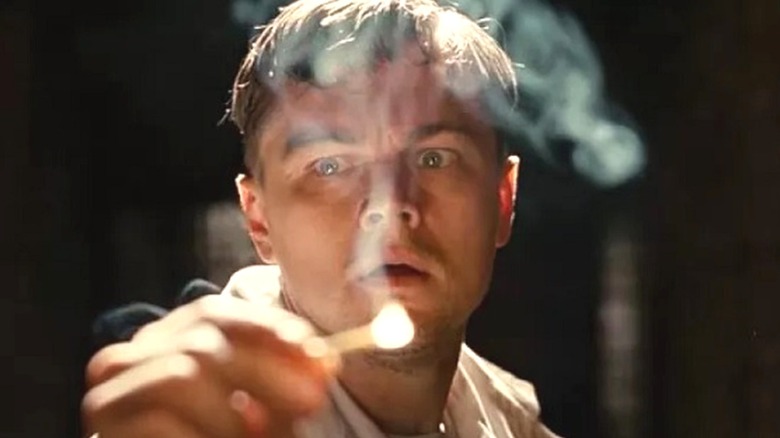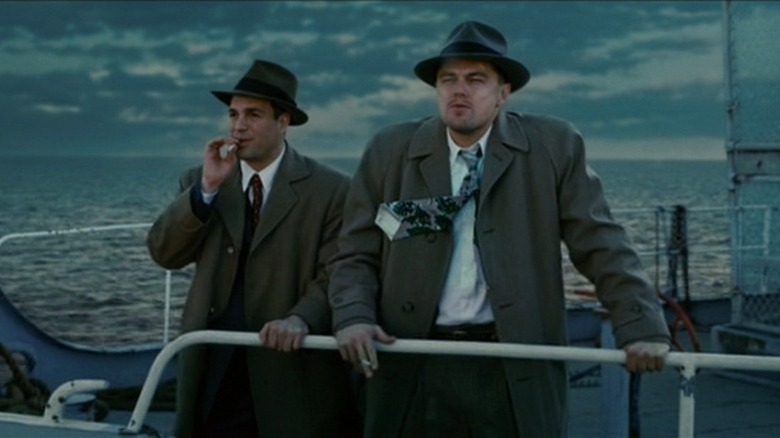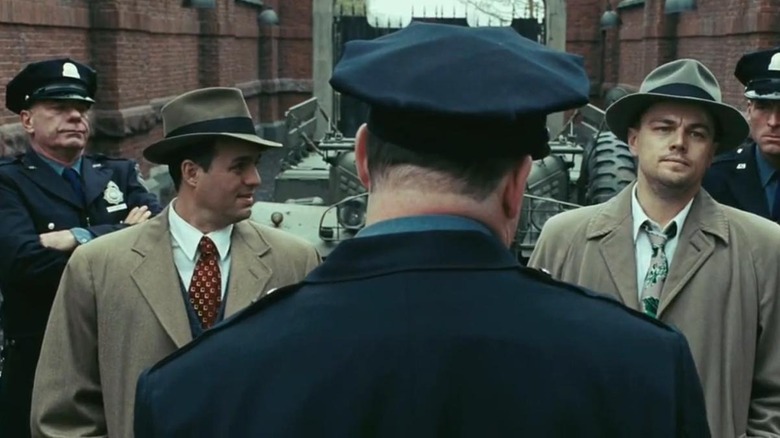The Big Clue Everyone Missed Early In Shutter Island
Martin Scorsese's 2010 feature "Shutter Island" is a gripping psychological thriller with twist after exciting twist. It's also the second highest-grossing movie of the director's career (via The Numbers), and it remains popular on Netflix.
At first, the film appears to tell the story of Teddy Daniels (Leonardo DiCaprio), a U.S. Marshal investigating the disappearance of a patient named Rachel Solando from a mental hospital located on Shutter Island, an isolated outpost in Boston Harbor. For this case, Teddy is working with his new partner, Chuck Aule (Mark Ruffalo). While at the hospital, Teddy begins experiencing migraines and hallucinations; everything is strangely off in a way he doesn't understand.
He goes deeper and deeper down his rabbit hole of madness until he finally confronts Dr. Cawley (Ben Kingsley), the doctor running the Shutter Island facility. Cawley explains to him that he's not Teddy Daniels; instead, he's Andrew Laeddis, a traumatized man who murdered his wife after she drowned their three children. The disappearance Teddy believes he's been investigating has actually been an experimental treatment to try to cure him of his manic delusion. The Shutter Island doctors hope that by indulging Laeddis' belief he is Teddy Daniels, he'll be able to come to the conclusion on his own about what happened and accept what he did. The hospital staff has been participating in the charade, and Chuck Aule is actually Dr. Lester Sheehan, his primary doctor on Shutter Island.
There's a big clue very early in "Shutter Island" that you may have missed the first time around because it feels pretty subtle. In retrospect, the big clue is totally obvious in a satisfying way.
Teddy and Chuck's first scene together is stranger than it looks
The great thing about "Shutter Island" is that it's a very different experience watching the movie with knowledge of the twist versus not knowing. The second time watching it, you can see all the ways Scorsese hints at what's really happening before it's revealed. These hints start from the very first scene, which takes place on the ferry out to Shutter Island.
Teddy is throwing up in the bathroom because he "can't stomach the water," which he thinks is because he's seasick. Actually, it's because he's withdrawing from his medication and the water reminds him of the water in which his wife drowned their children.
He goes up to the deck and meets Chuck Aule, his new partner. Teddy doesn't seem to think it's weird that he's meeting Chuck for the first time on deck. Logically they would have gotten on the ferry together, you would think. Since the film doesn't make a point of underlining how strange Teddy and Chuck's introduction is, it's easy to accept it as a normal event. But it's the first big clue that things are not what they seem at Shutter Island and something is very off with Teddy.
There are other big hints about the "Shutter Island" twist contained in the opening scene, too. One such hint is that Teddy doesn't have a cigarette lighter. As a patient, he's probably not allowed to have one because it's a dangerous item. Additionally, the boat bathroom looks suspiciously like the kind of cell where a patient living in a 1950s institution would be held. But it's the meeting of Aule and Daniels that should immediately tip off viewers that something strange is afoot but is only noticed by the most eagle-eyed.
Many scenes read differently when you know the twist
Numerous hints lead up to the big "Shutter Island" twist. Looking back on it, the movie's practically shouting at you, "Teddy Daniels is Andrew Laeddis!" It's a film that rewards rewatches, and you'll realize certain moments come across differently with the knowledge of Teddy's true identity. When Teddy and Chuck first arrive on the island, the guards grip their guns a little tighter. On your first watch, audiences may think there are secrets on the island they need to protect. In actuality, the guards are nervous because they know Teddy's actually one of the patients, and they don't know if he could snap any second.
Another bit of foreshadowing occurs when the U.S. Marshals have to relinquish their guns. There's a prolonged moment where Chuck fumbles getting his firearm out of its holster. If he were actually an experienced Marshal, he should have no problem getting it undone. The reason he has an issue is that he's really a doctor. He doesn't know how to handle a gun properly. Initially, the scene comes across amusingly, but it gives up the entire twist right there.
With all this in mind, it just goes to show what a master filmmaker Martin Scorsese is. He hid all of these clues in plain sight, and many people were still taken by surprise.


